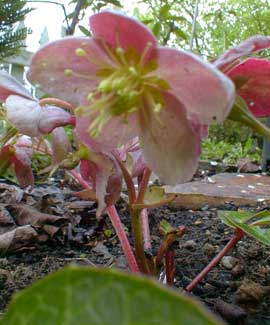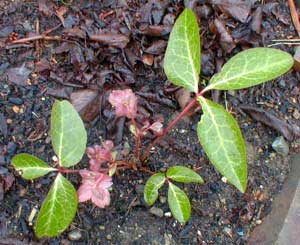
Majorca Island Hellebore;
or, Livid Hellebore
"December brings the thorn that flowers in vain,
Or hellebore, like a girl-murderess,
Green-eyed & sick with jealousy, & white
With wintry thoughts of poison."
-Sydney Thompson Dobell
(1824-1874)
(1824-1874)
We got a tiny start of Hellebore lividus (formerly H. argutifolius) from Heronswood, as I was attracted to what on the wee three-month-old seedling were round pewter-mottled leaves, very pretty. We didn't know how big it would get, what the leaves would look like when older, what its flowers would be like, nothing, just those cute baby leaves.
Well, as it turned out, the cute round mottled leaves mature into enlongated leathery toothy bluish grey-green & silver-webbed leaves, scarsely resembling the baby leaves.
The flowers are a mix of pale green & dusty flat pink. For us it is getting ready to bloom in December, but reaches its peak in March; then, as with hybrid hellebores, the blooms last & last almost as though they were made out of silk.
It is sometimes a floppy plant, & always very low-growing, only three or six inches high on extremely short stems, though the leaves spread out to about a foot or fifteen inches wide.
It took two full years for the seedling to begin to look like anything even slightly impressive. The April photo above was hard to take, as the inches-short flowers hang almost onto the surface of the ground. There is no angle from above that the plant is particularly interesting (the second photo taken in March shows its few mature leaves & its flowers from overhead), but if you can get down on your belly & see it from underneath, it's kind of cool.
 We planted it on a raised ledge about two feet high, which is still too low to see it at eye-level or lower with any great ease. Even though we didn't know what we were buying, it was quite a pig in a poke, as it's a strange cool flower. It's thrililng more as a novelty than for looks, but it may yet mature into something that will impress the average viewer.
We planted it on a raised ledge about two feet high, which is still too low to see it at eye-level or lower with any great ease. Even though we didn't know what we were buying, it was quite a pig in a poke, as it's a strange cool flower. It's thrililng more as a novelty than for looks, but it may yet mature into something that will impress the average viewer.It is reportedly very fragile, liking neither heat nor frost, but it has caused us no trouble. It's not a plant that likes winter, & there are not many places in the United States where the weather never quite suits it at all, though Puget Sound's mellow microclimate seems fine for it.
In northwest Majorca, in grows in shade; but for the Pacific Northwest full sun is usually recommended, except for needing protection from summer's long hot droughty days. We may have ours in too much shade & it would become bushier & more impressive in full sun. It's underneath a sweet cherry & only gets a great deal of sun in the winter when the tree has no leaves. It blooms well where its at, though, & has been quite sturdy rather than tender even if a little thinly leafed; so I'm not about tempt fate by moving it.
Heronswood said, "Our strain is seemingly better flowered than others we have observed, & is derived from wild collections from Majorca by Gisela Schmiemann." It is often but not invariably monocarpic, dying after baring fruit. I've no idea if pinching the fading flowers before they bare fruit would keep it alive longer, but even if permitted to fruit, it should bloom for several seasons before it fruits.
As it is not usually longlived it's anybody's guess how long it will be with us, but it certainly has not yet shown signs of being in decline. The specimen we have is a true species hellebore, not hybridized. But it has been used in curious hybrid experiments, some of the resulting crosses reaching the marketplace from a very few specialist plant sellers.
Though not really suitably grown outside of zone 7-9 (unless in pots that can be brought to shelter when temperatures get cold) there are nevertheless gardeners who have reported that theirs thrived for leafy growth in USDA in Zone 6 & occasionally 5b, but were not apt to bloom, the silvery mottled leaves having to be sufficient to justify themselves.